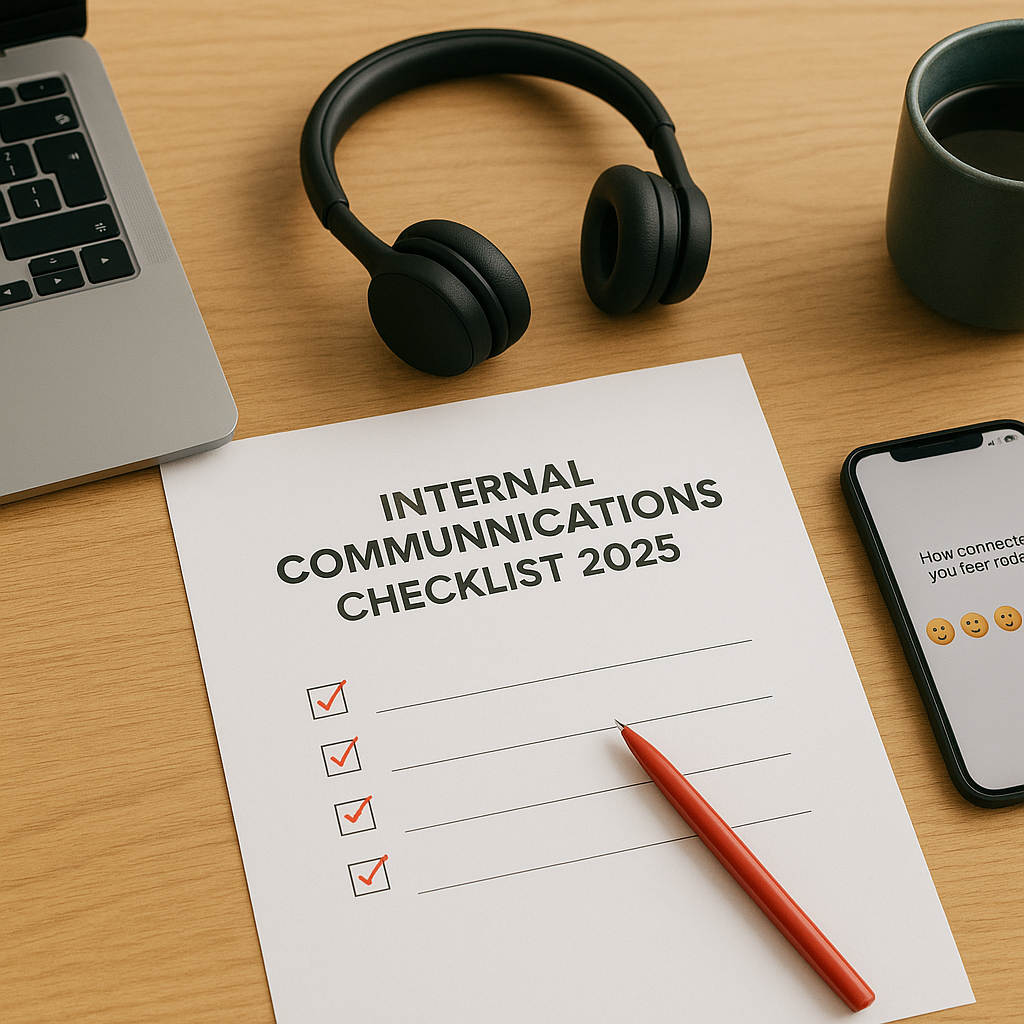Is your team disengaged, overwhelmed by emails, and missing critical updates?
Only 14% of Australian workers feel their workplace fosters innovation—highlighting a deep disconnect in internal communications. Effective internal communication is no longer optional; it’s essential, especially in today’s hybrid and remote working landscape.
Quick Look: The 10-Point Internal Communications Checklist
- Run a Communications Audit
- Set Business-Linked Goals & KPIs
- Map Your Audiences & Personas
- Craft Core Messages & Story Arcs
- Choose Your Channel Mix
- Select & Integrate the Right Tech Stack
- Enable Leaders & Champions
- Personalise & Schedule Content
- Launch, Listen & Iterate
- Build a Crisis-Ready Playbook
1. Run a Communications Audit
Begin by understanding your current state:
- Survey employees to measure engagement levels.
- Conduct interviews and focus groups for qualitative insights.
- Review analytics on existing channels (email open rates, intranet usage).
Check back for our free audit template!
2. Set Business-Linked Goals & KPIs
Establish clear, measurable goals linked directly to organisational objectives:
- Increase employee satisfaction (ESAT scores).
- Enhance innovation and idea-sharing culture.
- Improve adoption of internal platforms.
- Track employee understanding of strategic changes.
3. Map Your Audiences & Personas
Clearly segment your employees:
- Desk-based vs frontline and remote workers.
- Contractors vs full-time employees.
- Identify specific needs and communication preferences (e.g., mobile apps, videos, emails).
4. Craft Core Messages & Story Arcs
Ensure messages align with external branding:
- Consistent language and themes.
- Clear narrative arcs that support organisational culture.
- Showcase authentic employee stories and achievements.
5. Choose Your Channel Mix
Diversify your communication channels:
- Email (targeted, personalised).
- Mobile apps and intranets.
- Digital signage for frontline workers.
- Virtual town halls, podcasts, and short-form video.
6. Select & Integrate the Right Tech Stack
Evaluate platforms objectively:
- Employee-experience or engagement platforms.
- Consolidate communication, surveys, and content distribution.
- Compare licensing, ease of use, analytics capabilities, and integration options (Slack, Teams, HRIS).
7. Enable Leaders & Champions
Equip your leaders and internal champions to communicate effectively:
- Provide micro-training sessions.
- Equip them with engaging video scripts or podcast talking points.
- Foster a culture where leaders visibly engage and champion internal comms.
8. Personalise & Schedule Content
Optimise content delivery:
- Develop a segmented content calendar.
- Leverage AI to draft and personalise content efficiently.
- Schedule communications based on peak engagement analytics.
9. Launch, Listen & Iterate
Implement with a feedback-driven approach:
- Launch communications clearly and transparently.
- Regularly measure employee feedback through pulse surveys.
- Adapt based on real-time analytics and feedback.
10. Build a Crisis-Ready Playbook
Be proactive, not reactive:
- Establish clear communication protocols for crises.
- Define roles and response timelines (e.g., first 48-hour critical communications checklist).
- Train key staff regularly to ensure readiness.
Need help? Partner with Connective Works
Connective Works provides unbiased, expert advice on:
- Conducting thorough internal communications audits.
- Selecting and implementing the right communication platforms.
- Producing engaging content to energise your internal channels.
- Navigating change management communications effectively.
Effective internal communications in 2025 require authenticity, personalisation, and measurable impact. Adopt a structured approach, stay agile, and continuously refine your strategy for sustained employee engagement and organisational success.
FAQs
How often should we audit internal communications?
Conduct comprehensive audits annually and mini-audits quarterly to ensure continuous improvement.
What metrics effectively measure internal communications?
Metrics include employee engagement scores, platform adoption rates, employee satisfaction, feedback surveys, and communication analytics.
How do we effectively communicate with non-desk staff?
Use mobile-first platforms, SMS, digital signage, and tailored face-to-face briefings.
Why is personalisation important in internal comms?
Personalised communications increase relevance, engagement, and effectiveness, reducing information overload.

